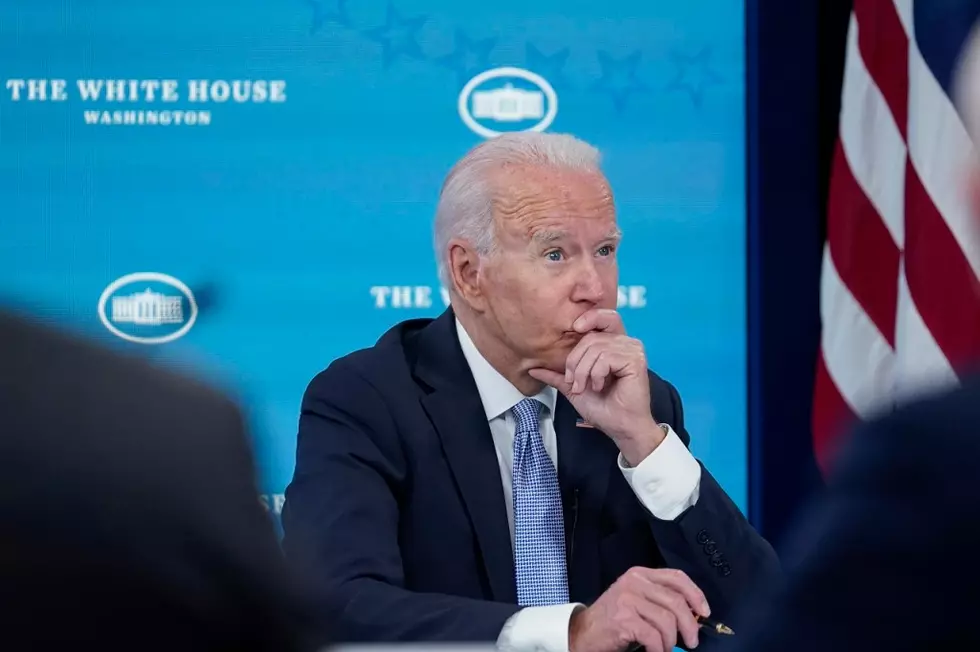
Biden talks wildfires with Western governors; Gianforte ‘left out’ of meeting
(CN) — Amid a sweltering heat wave, President Joe Biden met with Western state governors on Wednesday promising to bolster wildfire prevention and federal firefighter pay.
Vice President Kamala Harris, top Cabinet officials and private sector partners also assembled in-person and remotely to take part in Wednesday’s conversation, which Biden led from the South Court Auditorium at the White House.
There he announced a temporary raise in pay for federal firefighters from about $13 an hour to at least $15 and an additional bonus for those on the front lines.
“The threat of Western wildfires this year is as severe as it’s ever been,” Biden told the assembly of governors, FEMA and administration leadership.
He said that the meeting will become an annual event, focused on both fire prevention and response.
According to the National Interagency Fire Center, much of the Western U.S. has an “above normal” potential of experiencing wildfires this year.
This increase in fire potential during 2021 follows a harrowing pattern — every year since 2015, the U.S. has experienced about 100 more major wildfires than the previous year.
“We’re playing catch up,” Biden said during the briefing, noting that about 9,000 firefighters are deployed across the western region, “and it’s only June.”
Climate change, he said, is driving the confluence of record heat and prolonged drought conditions that contribute to the formation of wildfires.
Last year, California experienced the worst wildfire season in the state’s history, which scientists and government leadership attributed to the climate crisis.
Biden announced that the state, which has already seen fire-related evacuations this year, will receive a $37 million federal grant to aid Sonoma County.
The nation is seeing fires of “greater intensity that move with more speed, and last well beyond traditional months in the fire season,” Biden said.
Traditionally, federal firefighting has been a seasonal job, but climate change has made it a “year-round mission,” he said, expressing a need for a higher number of firefighters who are on-call, and “trained, equipped and ready to respond for all this fire season.”
Biden’s plan also entails harnessing new tools and technology to respond before new fires ignite. He pointed to satellite technology that can be used by the National Oceanic and Atmospheric Administration to spot fires the size of a dining room table from space.
Other tools include technology that can track blaze-causing lightning strikes in real-time and launching a new app from the Environmental Protection Agency that would allow individuals to readily access information such as air quality.
“Just this weekend, my state of Oregon experienced three consecutive days of record-breaking high temperatures across the Willamette Valley, reaching upwards of 117 degrees. It is unprecedented, and, unfortunately, it follows one of the most devastating wildfire seasons in our state’s history.” said Democratic Oregon Governor Kate Brown on Wednesday.
“Last year we had more than 2,000 fires that burned over a million acres,” she added, noting that communities of color and low-income communities are disparately impacted.
Since then, she said, the state has worked to shore up emergency staffing to support local and tribal partners.
Brown urged the administration to ensure that everyone impacted by wildfires, including undocumented immigrants, are eligible for FEMA assistance.
After Biden asked Brown what she would like to see happen at the federal level, she asked the president to help make sure her state has the resources to train National Guardsmen and women ahead of fire season.
For years, the president has received a briefing at the beginning of a hurricane season for the East Coast but Biden said that he also asked for a briefing on wildfires.
Brown expressed concern that receiving aid from Eastern states may be more difficult this year, as they are expected to face an increased number of hurricanes in the upcoming season.
“I’ve been waiting almost 4 and half years to hear a president say what you just said,” remarked California Governor Gavin Newsom, taking a jab at former President Donald Trump’s previous “finger-pointing” approach to the discussion of wildfires.
“The hots are getting hotter and the drys are getting drier,” said the Democratic governor, adding, “For those that don’t believe in science, believe your own damn eyes.”
Vice President Harris joined the meeting on Wednesday afternoon, contending that the administration’s bipartisan infrastructure framework could help mitigate the devastating impact of wildfires.
She said strategic water policy and the incentivized engagement of the private sector are also part of the solution.
Calling for continued cooperation among the leadership of impacted states, the president noted that “wildfires are not a partisan phenomenon.”
Wyoming Governor Mark Gordon, Governor Jay Inslee of Washington, Utah Governor Spencer Cox, Colorado Governor Jared Polis, Nevada Governor Steve Sisolak and Governor Michelle Lujan Grisham of New Mexico all participated in the meeting on Wednesday.
Idaho Governor Brad Little and Montana Governor Greg Gianforte, both Republicans, said in a statement on Wednesday that they were “left out” of the meeting.
“No state in what it faces and how it responds is like another,” the governors wrote in a letter to Biden. “We were disappointed to learn not all western states who face a harsh wildfire season will be at the table.”
